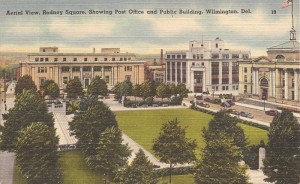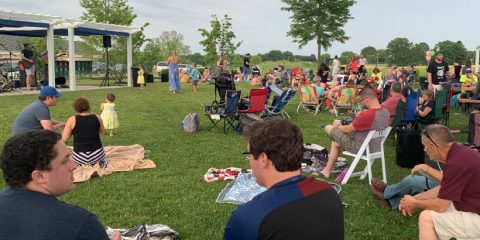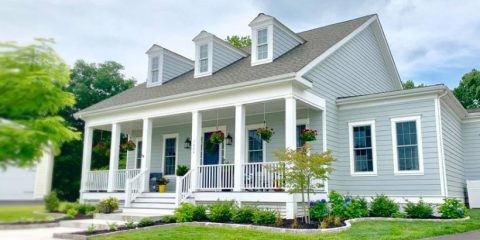The Delaware Way Happens in the Town Square

One of the best parts of my job is seeing our community at its best. The fact that we come together in the “town square” to voice our concerns, work out our differences and celebrate our individual and collective progress is my definition of the Delaware Way. And guess where it is happening? In the town square…Rodney Square!
Public squares have had importance in cultures for thousands of years. According to international planning expert, Howard Blackson, “The Square continues to resonate in America’s civic experience. The American Square, a full block of civic spaces fronted by public and private buildings are our reinterpretation of the English church square, Spanish civic plaza, France’s residential square and the Italian Renaissance era of grand civic spaces. The Square lives on in contrast to our domesticity, quiet and private everyday lifestyle with its imposing monumentality and bustle of civic life.”
According to Garden Club of Wilmington documents, in 1902, three du Pont cousins, Pierre, Coleman and Alfred began reorganizing the DuPont Company, including the consolidation of their operations at 10th and Markets Streets. For 19 years, Pierre du Pont encouraged and assisted the construction of a group of buildings in the classical style around a public square to complement the new DuPont Company headquarters. In 1916, Irenee du Pont, then the DuPont Company president and park commissioner, launched a campaign to select an architect to develop the square into a park. It was completed in 1921.
 The City Beautiful Movement that was sweeping around the country inspired the design. Great civic buildings were built at the square in an effort to boost the city’s standing in the region and to improve the quality of life for residents, merchants and the emerging commercial business community. The civic space was built adjacent to the existing DuPont Company headquarters and the Wilmington Public Building (completed in 1916) and saw the emergence of the Wilmington Public Library in 1922, and the Wilmington Post office in 1937.
The City Beautiful Movement that was sweeping around the country inspired the design. Great civic buildings were built at the square in an effort to boost the city’s standing in the region and to improve the quality of life for residents, merchants and the emerging commercial business community. The civic space was built adjacent to the existing DuPont Company headquarters and the Wilmington Public Building (completed in 1916) and saw the emergence of the Wilmington Public Library in 1922, and the Wilmington Post office in 1937.
Rodney Square, according to Pam Sapko, Executive Director of the Delaware Center for Horticulture, “…sits at the core of Wilmington’s park system.” Sapko and her organization take an active role, in partnership with the City of Wilmington, to make sure that the 80 parks within the city properly serve the residents of our State and our guests. Sapko sees Rodney Square as possibly being “the most important” park because it is the physical beginning of the Route 52 scenic byway.

Trees for Rodney Square’s many phases are growing at Longwood Gardens; the described form of protection is used for the root system
Upgrades for the Square are nothing new, but this phase is unique. In 1996, the Garden Club of Wilmington led a multimillion-dollar restoration of the landscaping, irrigation system and landscaping. Mayor Dan Frawley contributed to the effort by having the failing statue of Caesar Rodney saved through a two year repair and reconditioning process. The partnership of public and private fundraising for the effort helped to fast track the project. Mrs. Charles F. Richards III and Mrs. Calhoun W. Wick of the Garden Club of Wilmington were on hand to dedicate the new park in 1997 Mr. Rodney Robinson designed the 1996 upgrade in collaboration with EDiS Company.
Today, the Delaware Center for Horticulture is facilitating an improvement to the landscaping and extending the life of Rodney Square for decades. They have provided design guidance, raised a portion of the money and inspired collaboration. The design will include a unique rooting technology so new trees don’t suffer the same over-compaction as they currently stand. Most of the trees that will be placed at Rodney Square are being grown at Longwood Gardens, a collaboration designed to reduce costs and ensure uniformity of tree size (tree replacement will happen over several years).
 Sapko was pleased to see the involvement of so many people and organizations in the development of the $1,000,0000 Rodney Square upgrade including the Garden Club of Wilmington, the Clifford Brown Jazz Festival, the Wednesday Farmers Market and the Wilmington Grand Prix. Rodney Square has certainly served the purpose that Mr. du Pont had hoped for and Blackson described. It has seen Christmas caroling and the Occupy Wall Street movement. It has seen politicking by presidents Richard Nixon and Barrack Obama and has provided space for us to celebrate our local culture and pray during national crisis. Most of all, it provides us a beautiful park to rest and relax…sometimes.
Sapko was pleased to see the involvement of so many people and organizations in the development of the $1,000,0000 Rodney Square upgrade including the Garden Club of Wilmington, the Clifford Brown Jazz Festival, the Wednesday Farmers Market and the Wilmington Grand Prix. Rodney Square has certainly served the purpose that Mr. du Pont had hoped for and Blackson described. It has seen Christmas caroling and the Occupy Wall Street movement. It has seen politicking by presidents Richard Nixon and Barrack Obama and has provided space for us to celebrate our local culture and pray during national crisis. Most of all, it provides us a beautiful park to rest and relax…sometimes.
 Rodney Square is going through an identity crisis of sorts as public agencies pull and tug at this great civic space. With its location being central to the business district, the Department of Transportation has taken advantage of the square by making it a transportation center. And while planners would be pleased that Rodney Square is frequented by our citizens, I am not sure they would be pleased at the gauntlet of buses and the volume of exhaust that now plagues the space. According the Blackson, “Surrounding the entire plaza with large, idling, noisy, visually obstructing buses in order to stage transit services at the expense of a great civic space that provides natural respite from the urban center is transit planning, not urban planning.”
Rodney Square is going through an identity crisis of sorts as public agencies pull and tug at this great civic space. With its location being central to the business district, the Department of Transportation has taken advantage of the square by making it a transportation center. And while planners would be pleased that Rodney Square is frequented by our citizens, I am not sure they would be pleased at the gauntlet of buses and the volume of exhaust that now plagues the space. According the Blackson, “Surrounding the entire plaza with large, idling, noisy, visually obstructing buses in order to stage transit services at the expense of a great civic space that provides natural respite from the urban center is transit planning, not urban planning.”
The good news in all of this is that Rodney Square is serving its purpose. It is charming, providing a center for activity and debate. And best of all, it continues to demonstrate the good that can come from collaboration between the private and public sector. We look forward to her centennial!

